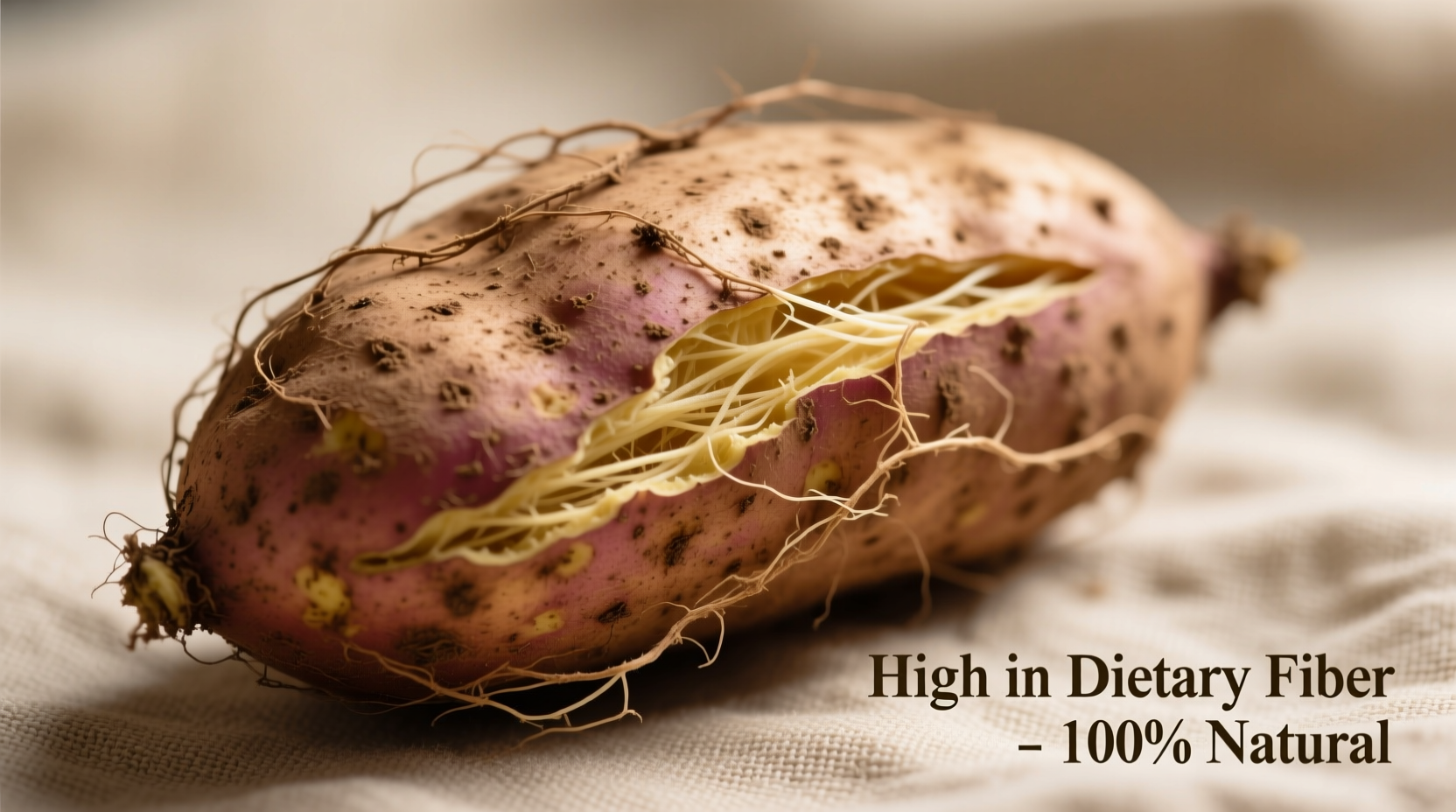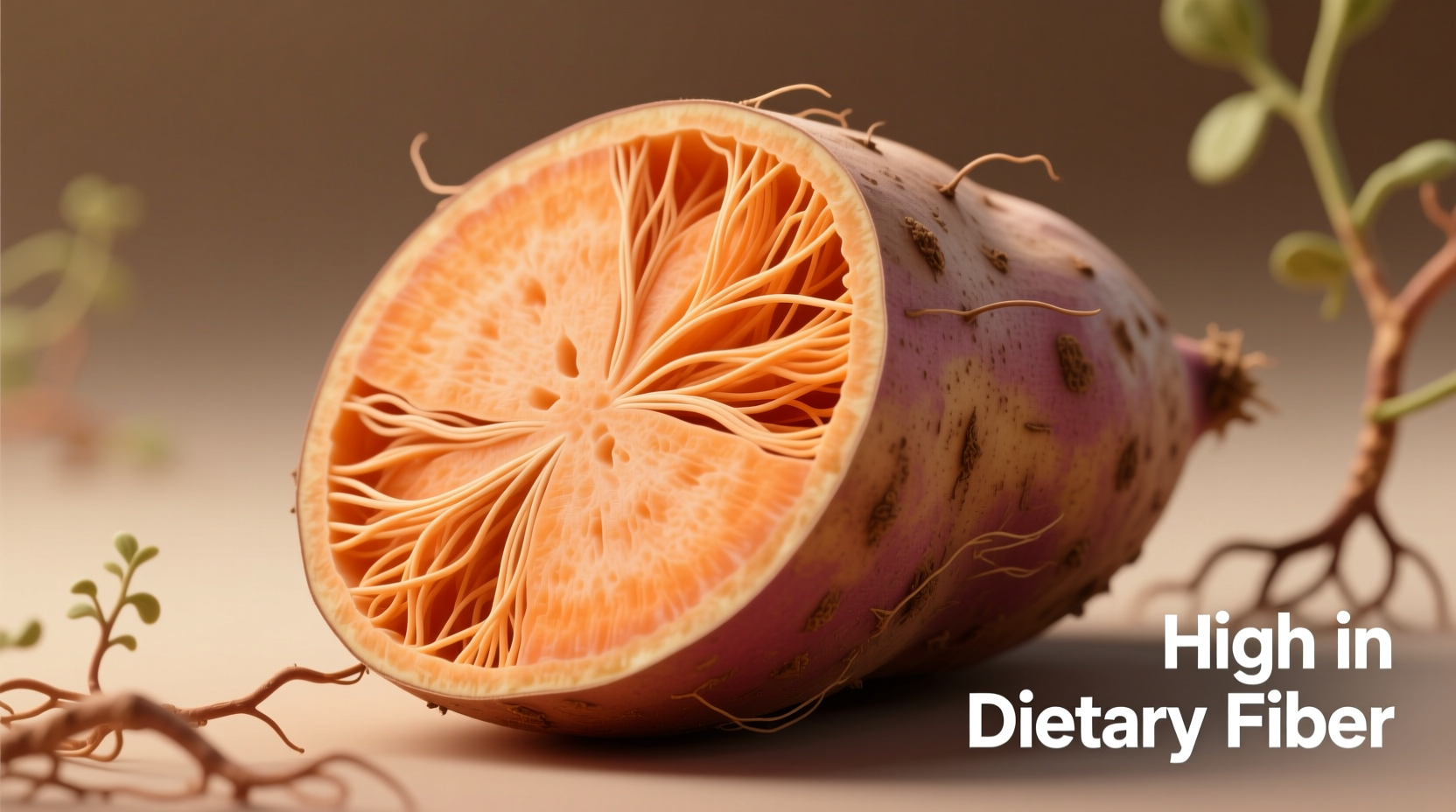When you're evaluating whether sweet potatoes fit into your high-fiber eating plan, you need clear, actionable information. This guide delivers precise fiber content data, preparation tips to maximize benefits, and science-backed insights to help you make informed dietary choices.
Why Sweet Potato Fiber Matters for Your Health
Dietary fiber plays a crucial role in maintaining digestive health, regulating blood sugar, and supporting heart health. Unlike processed fiber supplements, sweet potatoes provide fiber in its natural, whole-food form alongside essential vitamins and minerals.
The fiber in sweet potatoes works differently than in many other vegetables. It contains both soluble and insoluble fiber, each offering distinct health advantages. Soluble fiber helps manage cholesterol and blood sugar levels, while insoluble fiber promotes regular digestion and prevents constipation.
Sweet Potato Fiber Content: Verified Data
According to the USDA FoodData Central database, sweet potatoes deliver impressive fiber content regardless of preparation method. The table below shows exact measurements per standard serving:
| Preparation Method | Portion Size | Total Fiber (grams) | % Daily Value |
|---|---|---|---|
| Boiled, with skin | 1 medium (130g) | 3.8 | 14% |
| Baked, with skin | 1 medium (130g) | 3.6 | 13% |
| Steamed | 1 cup cubes (150g) | 4.2 | 15% |
| Mashed (without additives) | 1 cup (200g) | 5.0 | 18% |
This data comes directly from the USDA FoodData Central, the authoritative source for nutritional information in the United States. Notice that keeping the skin on preserves additional fiber, as the skin contains concentrated fiber content.
How Sweet Potato Fiber Compares to Other Foods
When evaluating high-fiber food options, context matters. Here's how sweet potatoes stack up against common fiber sources:
- Medium sweet potato: 3.8g fiber (14% DV)
- Medium regular potato (with skin): 2.9g fiber (10% DV)
- 1/2 cup cooked broccoli: 2.8g fiber (10% DV)
- 1/2 cup black beans: 7.5g fiber (27% DV)
- 1 medium pear (with skin): 5.5g fiber (20% DV)
Sweet potatoes offer a balanced fiber profile with the added benefit of beta-carotene, vitamin C, and potassium. Unlike beans which can cause digestive discomfort for some people, sweet potatoes provide moderate fiber levels that most digestive systems tolerate well.

Maximizing Fiber Benefits: Practical Preparation Tips
How you prepare sweet potatoes significantly impacts their fiber content and health benefits. Follow these evidence-based strategies:
Keep the Skin On
The skin contains nearly half the total fiber content. When boiled or baked with skin intact, you preserve maximum fiber. Always wash thoroughly before cooking.
Avoid Over-Processing
While mashed sweet potatoes still offer good fiber content, excessive processing breaks down fiber structure. For maximum benefit, try roasting cubed sweet potatoes with minimal processing.
Pair with Complementary Foods
Combine sweet potatoes with other high-fiber foods for synergistic effects:
- Add black beans to sweet potato bowls for complete fiber profile
- Top with chia seeds or flaxseeds for additional fiber boost
- Pair with leafy greens for diverse fiber types
Understanding Sweet Potato Fiber Types
Sweet potatoes contain both soluble and insoluble fiber, each serving different functions in your body:
Soluble Fiber (Approximately 60%)
This fiber dissolves in water to form a gel-like substance that:
- Slows digestion for better blood sugar control
- Helps lower LDL ("bad") cholesterol
- Feeds beneficial gut bacteria
Insoluble Fiber (Approximately 40%)
This fiber doesn't dissolve in water and:
- Promotes regular bowel movements
- Adds bulk to stool
- Helps prevent constipation
This balanced fiber composition makes sweet potatoes particularly valuable for comprehensive digestive health.
Common Misconceptions About Sweet Potato Fiber
Several myths persist about sweet potato nutrition. Let's clarify with evidence:
Myth: Sweet potatoes are too high in carbohydrates to be healthy
While sweet potatoes do contain carbohydrates, their high fiber content slows glucose absorption, resulting in a moderate glycemic index (44-61 depending on preparation). The fiber-carbohydrate balance makes them suitable for most dietary plans.
Myth: All cooking methods destroy fiber content
Research published in the Journal of Food Science and Technology shows that proper cooking actually makes some fiber components more bioavailable while preserving overall fiber content. Boiling and baking retain most fiber.
When Sweet Potatoes Might Not Be Your Best Fiber Choice
While sweet potatoes offer excellent fiber benefits, certain situations warrant consideration of alternatives:
- For immediate constipation relief: Foods higher in insoluble fiber like wheat bran may work faster
- For very low-carb diets: Options like avocados or chia seeds provide more fiber per gram of carbohydrate
- For those with digestive sensitivities: Some people find sweet potatoes cause bloating; start with small portions
For most people, however, sweet potatoes represent an ideal balance of fiber, nutrients, and culinary versatility.
Practical Ways to Add Fiber-Rich Sweet Potatoes to Your Diet
Incorporate sweet potatoes into your meals with these simple strategies:
- Replace regular potatoes with sweet potatoes in any recipe
- Add diced sweet potatoes to morning oatmeal for extra fiber
- Make sweet potato "toast" by slicing lengthwise and toasting
- Create fiber-rich salads with roasted sweet potato cubes
- Blend cooked sweet potato into smoothies for creaminess and fiber
Remember that consistent, moderate fiber intake throughout the day works better than large single doses. Adding one medium sweet potato to your daily menu significantly contributes to your fiber goals without overwhelming your digestive system.
Frequently Asked Questions
How much fiber is in a sweet potato compared to a regular potato?
A medium sweet potato (130g) contains approximately 3.8g of fiber, while a medium regular potato with skin contains about 2.9g. Sweet potatoes provide roughly 30% more fiber than regular potatoes of the same size, making them the superior choice for fiber intake.
Does cooking method affect sweet potato fiber content?
Cooking method has minimal impact on total fiber content. Boiled sweet potatoes with skin retain about 3.8g fiber, while baked versions have approximately 3.6g. The key factor is keeping the skin on, as it contains significant fiber. Avoid peeling after cooking to maximize fiber benefits.
Can sweet potatoes help with constipation?
Yes, sweet potatoes can help relieve constipation due to their balanced mix of soluble and insoluble fiber. The insoluble fiber adds bulk to stool while soluble fiber helps maintain proper moisture levels in the digestive tract. For best results, consume sweet potatoes with adequate water and as part of a varied high-fiber diet.
Are sweet potato skins safe to eat and do they contain fiber?
Yes, sweet potato skins are not only safe to eat but contain significant fiber—nearly half the total fiber content is in the skin. Always wash sweet potatoes thoroughly before cooking with the skin on. The skin also contains additional nutrients including antioxidants and potassium.
How many sweet potatoes should I eat daily for adequate fiber?
One medium sweet potato provides about 14-17% of your daily fiber needs. For optimal fiber intake, consume one sweet potato daily as part of a varied diet that includes other fiber sources like vegetables, fruits, legumes, and whole grains. Most adults need 25-38 grams of fiber daily, depending on age and gender.











 浙公网安备
33010002000092号
浙公网安备
33010002000092号 浙B2-20120091-4
浙B2-20120091-4